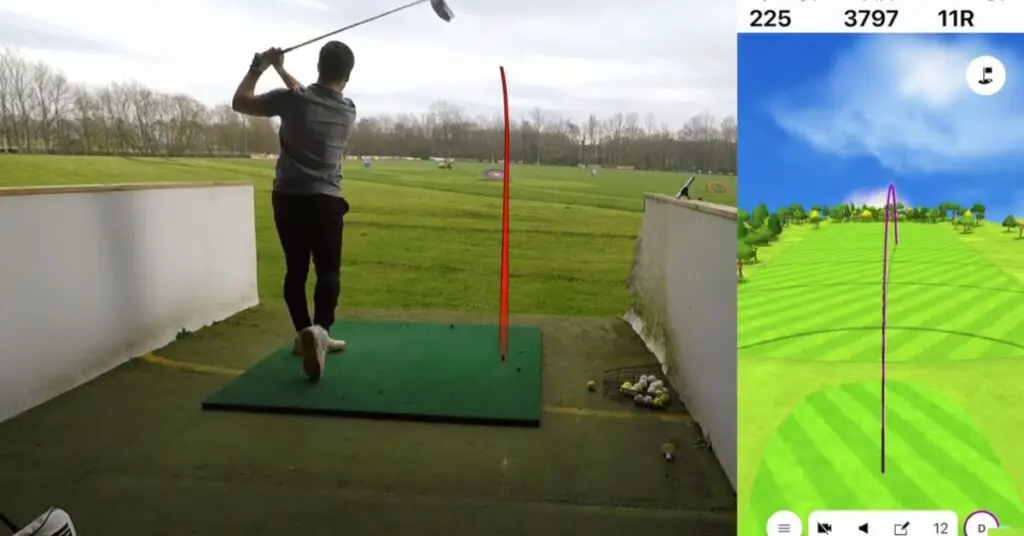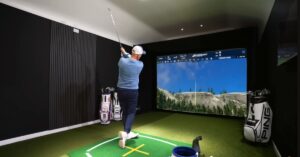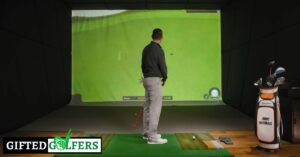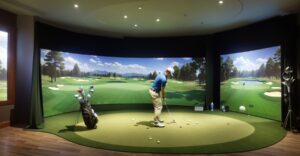Are Golf Simulators Accurate? A Comprehensive Look at Virtual Golf Technology!
Have you ever wondered if golf simulators can truly replicate the experience and accuracy of playing on a real course? Well, you’re not alone! As golf enthusiasts continue to embrace technology, the accuracy of golf simulators has become a hot topic.
Modern golf simulators have come a long way and can provide an incredibly accurate experience, thanks to advancements in sensor technology, software, and data analysis. However, it’s essential to note that not all simulators are created equal, and certain factors can influence the level of precision.
In this blog post, we’ll delve deeper into golf simulators, dissecting the factors contributing to their accuracy, comparing Golf Simulators to Real-Life Golf, and providing tips for getting the best out of it. Swing into the future of golf with confidence!

How do Golf Simulators Work?
Golf simulators work by using a combination of advanced technology and software to create a realistic golfing experience indoors. Here’s a breakdown of how they function:
Sensor technology
Golf simulators are equipped with a variety of sensors that track your swing, club movement, and ball flight.
These sensors use infrared light, cameras, radar, or a combination of these technologies to gather data on the club’s speed, angle, and path, as well as the ball’s launch angle, spin rate, and trajectory.
Hitting area
A designated hitting area, usually equipped with a hitting mat, is where the golfer takes their swing.
This area is designed to replicate the feel of standing on a real golf course, and the hitting mat often features different types of turf to simulate fairway, rough, and sand conditions.
Impact screen
When the golfer strikes the ball, it flies toward an impact screen or projection screen.
This screen is made of durable material that absorbs the energy of the ball, allowing it to fall safely to the ground.
The screen also doubles as a projection surface where the golf course’s virtual representation is displayed.
Simulation software
The software processes the sensor data and uses it to create a realistic virtual representation of the ball’s flight path, taking into account factors such as wind, terrain, and course conditions.
High-quality simulation software offers a wide range of course options, allowing golfers to play virtually on famous courses from around the world.
Display system
The virtual golf course is displayed on the impact screen or projected onto a large screen or even a wall.
This visual display provides the golfer with an immersive experience, making it feel like they’re playing on a real course.
Feedback and analysis
Golf simulators often provide real-time feedback and detailed analysis of each shot, giving golfers valuable insights into their performance.
This information can be used to adjust and improve their technique, ultimately enhancing their overall game.
Factors Affecting Golf Simulator Accuracy
While modern golf simulators offer impressive accuracy, several factors can affect their performance.
Here’s a list of some key elements that can influence a golf simulator’s precision:
Sensor technology
The quality and type of sensor technology used in a golf simulator play a crucial role in its accuracy.
High-end simulators often use a combination of camera systems, radar, and infrared sensors to capture detailed data about the club and ball.
In contrast, cheaper simulators may rely on less sophisticated sensors, resulting in less accurate readings.
Calibration
Regular calibration of the sensors and cameras is essential for maintaining the accuracy of a golf simulator.
Over time, the alignment of sensors may shift, leading to inaccurate measurements.
Ensuring the simulator is properly calibrated will help maintain its performance and precision.
Software quality
The software used to process the sensor data and generate the virtual golf course plays a significant role in simulator accuracy.
High-quality software will accurately account for factors like wind, ball spin, and terrain, resulting in a more realistic simulation of ball flight and course conditions.
Hitting mat quality
A good-quality hitting mat is essential for replicating the feel of a real golf course and providing accurate feedback on your swing.
Cheaper mats may not accurately simulate various turf conditions, which can impact your swing and the overall accuracy of the simulator.
Impact screen material
The quality of the impact screen can also affect the accuracy of the simulator.
A well-designed screen should absorb the ball’s energy and provide a consistent surface for projection.
Low-quality screens may result in distorted images or inaccurate ball flight data.
Lighting conditions
Proper lighting is crucial for accurate sensor readings, particularly for camera-based systems.
Insufficient or uneven lighting can lead to shadows or glare, causing the sensors to misread club and ball data.
User setup
A golfer’s stance, alignment, and distance from the sensors can all impact the accuracy of the readings.
Following the manufacturer’s guidelines for setting up the simulator and maintaining the correct position during each swing is essential.
Comparing Golf Simulators to Real-Life Golf
As you know, the factors that affect golf simulator accuracy. Now let’s compare golf simulators to real-life golf in terms of the overall experience, benefits, and limitations.
This comparison will help golfers understand how well simulators replicate the real-life golf experience and make an informed decision on using them for practice or leisure.
| Aspect | Golf Simulators | Real-Life Golf |
| Weather Conditions | Indoor, controlled environment | Dependent on outdoor conditions |
| Course Variety | Access to numerous virtual courses | Limited to local or accessible courses |
| Practice Time & Flexibility | Available anytime, 24/7 | Limited by daylight & course availability |
| Feedback & Analysis | Instant feedback & detailed analysis | Limited feedback, often requires a coach |
| Social Aspect | Can be played alone or with friends | Strong social aspect, played with others |
| Space & Setup | Requires dedicated space & equipment | Played on spacious, natural golf courses |
| Cost | Initial investment, lower ongoing costs | Ongoing costs for membership/fees |
| Skill Development | Ideal for skill development & practice | On-course practice, real-game experience |
Weather Conditions
Golf simulators allow players to enjoy the game in a controlled indoor environment, without being affected by weather conditions such as rain, wind, or extreme temperatures.
In contrast, real-life golf is subject to outdoor weather conditions, which can sometimes lead to canceled or postponed games.
Course Variety
Golf simulators offer access to numerous virtual courses from around the world, allowing golfers to experience famous courses without leaving their home or local facility.
Real-life golf is limited to the courses that are locally accessible or that the golfer can travel to.
Practice Time & Flexibility
Golf simulators provide the flexibility to practice anytime, regardless of daylight or course availability. Real-life golf is restricted by daylight hours and the availability of courses, which may limit practice time.
Feedback & Analysis
Golf simulators offer instant feedback and detailed analysis of each shot, helping golfers understand their performance and make improvements.
In real-life golf, feedback is often limited, and players may need to rely on a coach or video analysis for detailed insights.
Social Aspect
Both golf simulators and real-life golf can be played alone or with friends. However, real-life golf typically has a stronger social aspect, as players often engage with others on the course, in the clubhouse, or during tournaments.
Space & Setup
Golf simulators require a dedicated space and proper equipment setup, which may not be feasible for everyone.
Real-life golf takes place on spacious, natural golf courses, providing a different experience in terms of environment and aesthetics.
Cost
Golf simulators involve an initial investment for the equipment and setup, but generally have lower ongoing costs.
Real-life golf often incurs ongoing costs in the form of club memberships, green fees, and travel expenses.
Skill Development
Both golf simulators and real-life golf offer opportunities for skill development and practice.
Simulators provide a convenient and focused environment for practice, while real-life golf allows players to apply their skills in real-game situations and experience course nuances.
Top Golf Simulator Brands and Their Accuracy
Several top golf simulator brands offer high-quality and accurate golf simulations. While there are numerous options on the market, some of the best-known brands include:
#1- TrackMan Golf
TrackMan Golf is considered one of the most accurate golf simulators available.
It uses Doppler radar technology to track ball flight and provide precise data on ball speed, launch angle, spin rate, and more.
The accuracy and reliability of TrackMan’s data make it a favorite among professional golfers and coaches.
#2- Foresight Sports
Foresight Sports offers the GCQuad and GCHawk golf simulators, which utilize high-speed camera technology to capture images of the ball at impact.
This allows the system to provide accurate ball flight data and clubhead information.
Foresight’s GCQuad is known for its impressive accuracy, making it a popular choice for both amateurs and professionals.
#3- SkyTrak Golf
SkyTrak is a photometric launch monitor that uses high-speed cameras to capture the golf ball at impact. It provides accurate ball speed, launch angle, spin rate, and more data.
While not as precise as TrackMan or Foresight Sports, SkyTrak offers a more affordable option for golfers who still want reliable and accurate data.
#4- Full Swing Golf
Full Swing Golf simulators use infrared technology to track the ball and club data, providing a realistic golf experience.
The brand’s S2 Simulator and Pro Series Simulator are known for their accuracy and ability to analyze swing data.
While not as precise as TrackMan or Foresight Sports, Full Swing Golf simulators offer a reliable and engaging golf experience.
#5- aboutGOLF
aboutGOLF simulators use a combination of high-speed cameras and infrared technology to track ball flight and club data.
Their 3Trak system is designed to offer accurate ball flight data and a realistic golf simulation experience.
While not as accurate as some other top brands, aboutGOLF provides a solid balance of accuracy and affordability.
Tips for Ensuring Accurate Golf Simulator Experience
Achieving an accurate golf simulator experience is essential for players looking to improve their game and enjoy a realistic virtual environment.
Follow these ten tips to maximize the effectiveness of your golf simulator and enhance your overall performance on the course.
Choose a high-quality golf simulator
Invest in a golf simulator from a reputable manufacturer with a proven track record for accuracy and reliability.
Look for systems that utilize advanced tracking technologies, such as infrared sensors, radar, or camera-based systems.
Properly set up the simulator
Carefully follow the manufacturer’s instructions for setting up your golf simulator.
Ensure there is enough space to swing your clubs freely, a level surface to place the simulator, and proper lighting. Keep the sensors, cameras, and projector lens clean and well-maintained.
Accurate room dimensions
Measure your room dimensions precisely and input the correct measurements into the simulator software.
This will help ensure that the virtual environment accurately represents the space you have available for golf shots.
Calibrate the system
Periodically calibrate the simulator to maintain accuracy. This process usually involves hitting a series of shots with different clubs and adjusting the system’s settings based on your results.
Use the correct club data
Enter your club specifications into the simulator software, such as club length, loft, and lie angle. This will help the system generate more accurate shot data based on your unique equipment.
Use quality golf balls
Use high-quality golf balls that are in good condition for the most accurate readings. Damaged or low-quality balls can produce inconsistent results.
Maintain a consistent stance
Ensure that you maintain a consistent stance and ball position when using the golf simulator. This will help ensure that your swing and shot data are consistent and accurate.
Practice with a purpose
Focus on specific aspects of your game that need improvement, such as swing mechanics, clubhead speed, or shot shaping.
By practicing with a purpose, you will better understand how your swing affects shot outcomes and gain valuable insights into your game.
Update software regularly
Keep the simulator software up to date with the latest updates and improvements from the manufacturer.
This will help ensure that your system continues to provide accurate results as technology advances.
Seek professional help
If you’re struggling to achieve accurate results with your golf simulator, consider seeking help from a qualified golf instructor or technician.
They can help identify any issues with your swing or the system itself and suggest ways to improve your experience.
FAQs
How does a golf club simulator help with club fitting?
A golf club simulator can help with club fitting by measuring your swing and providing data on your clubhead speed, launch angle, spin rate, and more.
This information can be used to determine the optimal club specifications (such as shaft length, flex, and weight) for your individual swing, helping you achieve better performance on the course.
Is it worth investing in a golf club simulator for home use?
Investing in a golf club simulator for home use can be a great way to practice and improve your golf game year-round, regardless of weather conditions.
The cost of a simulator can vary greatly depending on the features and accuracy, so it is important to consider your budget and needs when making a decision.
Can golf club simulators be used for teaching and coaching?
Yes, golf club simulators can be a valuable tool for teaching and coaching. They provide instant feedback on a player’s swing, allowing instructors to identify areas for improvement and provide targeted instruction.
Additionally, they offer the ability to review and analyze swing data over time, helping students track their progress.





